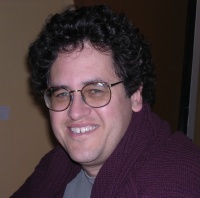Related Research Articles

Category theory formalizes mathematical structure and its concepts in terms of a labeled directed graph called a category, whose nodes are called objects, and whose labelled directed edges are called arrows. A category has two basic properties: the ability to compose the arrows associatively, and the existence of an identity arrow for each object. The language of category theory has been used to formalize concepts of other high-level abstractions such as sets, rings, and groups. Informally, category theory is a general theory of functions.

John Carlos Baez is an American mathematical physicist and a professor of mathematics at the University of California, Riverside (UCR) in Riverside, California. He has worked on spin foams in loop quantum gravity, applications of higher categories to physics, and applied category theory.
In mathematics, categorification is the process of replacing set-theoretic theorems with category-theoretic analogues. Categorification, when done successfully, replaces sets with categories, functions with functors, and equations with natural isomorphisms of functors satisfying additional properties. The term was coined by Louis Crane.
In mathematics, a tricategory is a kind of structure of category theory studied in higher-dimensional category theory.
In mathematics, an operad is concerned with prototypical algebras that model properties such as commutativity or anticommutativity as well as various amounts of associativity. Operads generalize the various associativity properties already observed in algebras and coalgebras such as Lie algebras or Poisson algebras by modeling computational trees within the algebra. Algebras are to operads as group representations are to groups. An operad can be seen as a set of operations, each one having a fixed finite number of inputs (arguments) and one output, which can be composed one with others. They form a category-theoretic analog of universal algebra.
In category theory, a branch of mathematics, a PROP is a symmetric strict monoidal category whose objects are the natural numbers n identified with the finite sets and whose tensor product is given on objects by the addition on numbers. Because of “symmetric”, for each n, the symmetric group on n letters is given as a subgroup of the automorphism group of n. The name PROP is an abbreviation of "PROduct and Permutation category".
In mathematics, higher category theory is the part of category theory at a higher order, which means that some equalities are replaced by explicit arrows in order to be able to explicitly study the structure behind those equalities. Higher category theory is often applied in algebraic topology, where one studies algebraic invariants of spaces, such as their fundamental weak ∞-groupoid.
In category theory, a weak n-category is a generalization of the notion of strict n-category where composition and identities are not strictly associative and unital, but only associative and unital up to coherent equivalence. This generalisation only becomes noticeable at dimensions two and above where weak 2-, 3- and 4-categories are typically referred to as bicategories, tricategories, and tetracategories. The subject of weak n-categories is an area of ongoing research.

In category theory, an abstract branch of mathematics, distributive laws between monads are a way to express abstractly that two algebraic structures distribute one over the other one.
This is a timeline of category theory and related mathematics. Its scope is taken as:
In mathematics, especially (higher) category theory, higher-dimensional algebra is the study of categorified structures. It has applications in nonabelian algebraic topology, and generalizes abstract algebra.

Ronald Brown is an English mathematician. Emeritus Professor in the School of Computer Science at Bangor University, he has authored many books and more than 160 journal articles.
In mathematics, a highly structured ring spectrum or -ring is an object in homotopy theory encoding a refinement of a multiplicative structure on a cohomology theory. A commutative version of an -ring is called an -ring. While originally motivated by questions of geometric topology and bundle theory, they are today most often used in stable homotopy theory.
In mathematics, the cobordism hypothesis, due to John C. Baez and James Dolan, concerns the classification of extended topological quantum field theories (TQFTs). In 2008, Jacob Lurie proposed a broadly-accepted solution. In 2021 a geometric version has been formulated by Daniel Grady and Dmitri Pavlov
In algebra, an operad algebra is an "algebra" over an operad. It is a generalization of an associative algebra over a commutative ring R, with an operad replacing R.
In mathematics, in particular abstract algebra and topology, a homotopy Lie algebra is a generalisation of the concept of a differential graded Lie algebra. To be a little more specific, the Jacobi identity only holds up to homotopy. Therefore, a differential graded Lie algebra can be seen as a homotopy Lie algebra where the Jacobi identity holds on the nose. These homotopy algebras are useful in classifying deformation problems over characteristic 0 in deformation theory because deformation functors are classified by quasi-isomorphism classes of -algebras. This was later extended to all characteristics by Jonathan Pridham.
In algebra, a higher-order operad is a higher-dimensional generalization of an operad.
In mathematics, specifically in category theory and algebraic topology, the Baez–Dolan stabilization hypothesis, proposed in, states that suspension of a weak n-category has no more essential effect after n + 2 times. Precisely, it states that the suspension functor is an equivalence for .
In algebra, given a 2-monad T in a 2-category, a pseudoalgebra for T is a 2-category-version of algebra for T, that satisfies the laws up to coherent isomorphisms.
In mathematics, an algebra such as has multiplication whose associativity is well-defined on the nose. This means for any real numbers we have
References
- ↑ Baez, John C.; Dolan, James (1997-02-10). "Higher-Dimensional Algebra III: n-Categories and the Algebra of Opetopes". Advances in Mathematics . 135: 145–206. arXiv: q-alg/9702014 . Bibcode:1997q.alg.....2014B. doi: 10.1006/aima.1997.1695 .
- Chapter 7 of Leinster, Tom (2003). Higher Operads, Higher Categories. London Mathematical Society Lecture Notes Series. Cambridge University Press. arXiv: math.CT/0305049 . ISBN 0-521-53215-9.